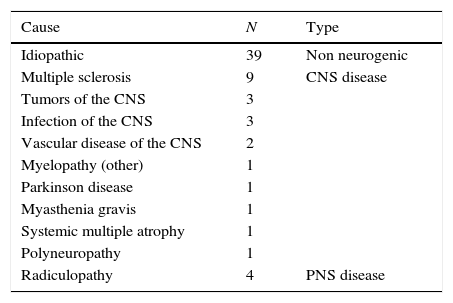To assess the efficacy of treatment with transcutaneous posterior tibial nerve stimulation (TPTNS) in patients with urge urinary incontinence, of neurogenic or nonneurogenic origin, refractory to first-line therapeutic options.
Material and methodsWe included 65 patients with urge urinary incontinence refractory to medical treatment. A case history review, a urodynamic study and a somatosensory evoked potentials (SEP) study were conducted before the TPTNS, studying the functional urological condition by means of a voiding diary. The treatment consisted of 10 weekly sessions of TPTNS lasting 30min.
ResultsSome 57.7% of the patients showed abnormal tibial SEPs, and 42% showed abnormal pudendal SEPs. A statistically significant symptomatic improvement was observed in all clinical parameters after treatment with TPTNS, and 66% of the patients showed an overall improvement, regardless of sex, the presence of underlying neurological disorders, detrusor hyperactivity in the urodynamic study or SEP disorders. There were no adverse effects during the treatment.
ConclusionsTPTNS is an effective and well tolerated treatment in patients with urge incontinence refractory to first-line therapies and should be offered early in the treatment strategy. New studies are needed to identify the optimal parameters of stimulation, the most effective treatment protocols and long-term efficacy, as well as its applicability to patients with a neurogenic substrate.
Evaluar la eficacia del tratamiento con la estimulación transcutánea del nervio tibial posterior (T-PTNS) en pacientes con incontinencia urinaria de urgencia, de origen neurógenico o no neurógenico, refractaria a las opciones terapéuticas de primera línea.
Material y métodosSe incluyeron 65 pacientes con incontinencia urinaria de urgencia refractaria a tratamiento médico. Antes de T-PTNS se realizó anamnesis, estudio urodinámico y potenciales evocados somatosensoriales (PESS), estudiando el estado funcional urólogico mediante un diario miccional. El tratamiento consistió en 10 sesiones semanales de T-PTNS de 30 minutos de duración.
ResultadosUn 57,7% de los pacientes presentaban PESS tibiales anormales y en un 42% PESS pudendos anormales. Se objetivó una mejoría sintomática estadísticamente significativa en todos los parámetros clínicos tras el tratamiento con T-PTNS, y en el 66% se evidenció una mejora global, independientemente del género, presencia de alteraciones neurológicas de base, hiperactividad detrusoriana en el estudio urodinámico o trastornos en los PESS. No se produjeron efectos adversos durante el tratamiento.
ConclusionesT-PTNS es un tratamiento efectivo y bien tolerado en pacientes con incontinencia de urgencia refractaria a terapias de primera línea, y debería ser ofrecida precozmente en la estrategia de tratamiento. Son necesarios nuevos estudios para identificar los parámetros óptimos de estimulación, los protocolos de tratamiento más efectivos y la eficacia a largo plazo, así como su aplicabilidad a pacientes con un sustrato neurogénico.









